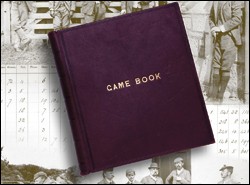Gamebooks: a peep into the past

Ranging from beautiful handmade leather-bound volumes to cheap paper-covered ledgers, since the mid-18th century, keepers, sportsmen and landowners have kept gamebooks in order to record game and vermin killed on country estates, farms, and other properties used for shooting and fishing. These books not only contain bag figures, names of Guns and information about the various quarry and predatory species present, but can also provide useful information for the game managers, sportsmen, naturalists, ornithologists and social historians of the future.
Interesting reading
Gamebooks kept by 19th century sportsmen, especially those who spent long periods abroad, often make interesting reading for the sportsman and historian alike. Sir Francis Denys Bt, the Victorian diplomat and sportsman, travelled to various parts of the world during the course of his career and was always accompanied by rod and gun. He took a particular delight in recording rare or unusual sporting achievements rather than big bags. During his period as British chargé d’affaires in Mexico in 1890, he notes that he spent a day on horseback on the edge of a lake shooting at snipe, teal and duck, accounting for a total of 35, all of which were retrieved by “a naked Indian boy” who ran into the water after each bird was shot. On another occasion in Mexico, he recalls going out in pursuit of rose-coloured spoonbill, which he considered to be “a very sporting quarry species”.
Every personal gamebook has entries relating to red-letter days, be it about an outstanding bag or simply an enjoyable outing spent on the shooting field, grouse moor or river. Henry Grey Thornton, an Exmoor squire who lived solely to hunt, shoot and fish, and who chose both of his wives for their horsemanship rather than their looks, recorded plenty of days. In particular the day in June 1923, when he landed a record 56lb salmon from the Pol Verie Pool on the river Awe, in Argyll, after a two-and-a-half hour fight, then drank a few drams of his favourite Scotch whisky in celebration; or the day in January 1901, when he managed to take out 11 badgers on an expedition at Stockham; or the day in September 1905, when he succeeded in bringing down a solitary blackgrouse on Exmoor.
Many gamebooks contain entries of interest to the naturalist or the ornithologist, though sportsmen often shot anything unusual on sight to provide tangible evidence of the presence of a rare bird or animal. The gamebook for the Galson estate on the Isle of Lewis, in the Outer Hebrides, notes that two snowy owls were shot in 1850, and that on the 10 November 1913, an un-named Gun bagged a Carolina goose on Ness Bog, which was sent to the Natural History Museum in London, being the “4th recorded in the British Isles”.
Law-breaking and poachers
Some gamebooks not only record large or unusual bags, but also cite examples of law-breaking, such as shooting pheasants out of season, or contain information pertaining to members of the poaching community. For instance, a gamebook kept by a now-deceased RAF officer, which turned up at a West Country antiques fair, records that he shot a hen pheasant on 21 September 1972 on a partridge shoot at Tidworth Garrison, in Hampshire. While a gamebook from the 1960s belonging to Harry Grass, headkeeper on the Broadlands estate, in Hampshire, contains bag figures at the front and has an appendix listing the names of known poachers, the make and registration of their cars.
Last but not least, gamebooks can often contain interesting entries that echo current events, particularly those kept during the late 19th and the early 20th centuries. For example, the gamebook at Grimersta Lodge on the Isle of Lewis records that on the 4 May 1926, four Rods accounted for six salmon and four brown trout — adding that the anglers were unable to leave after they had reached the mainland due to a “strike of coal miners, railwaymen and transport workers”.
Historic gamebooks contain a wealth of information about shooting when big bags were the order of the day and game management took precedence over the demands of farming activities on many great estates. These documents can paint a picture of a vanished way of life far more accurately than many of the books written by academics and others about the countryside past. Though relatively scarce today, old gamebooks, account books and other shoot-related ephemera are now highly collectable, especially if they contain information about well-known sportsmen, and can fetch high prices at auction.








